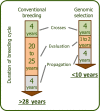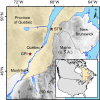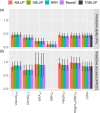Multi-trait genomic selection for weevil resistance, growth, and wood quality in Norway spruce
- PMID: 31892945
- PMCID: PMC6935592
- DOI: 10.1111/eva.12823
Multi-trait genomic selection for weevil resistance, growth, and wood quality in Norway spruce
Abstract
Plantation-grown trees have to cope with an increasing pressure of pest and disease in the context of climate change, and breeding approaches using genomics may offer efficient and flexible tools to face this pressure. In the present study, we targeted genetic improvement of resistance of an introduced conifer species in Canada, Norway spruce (Picea abies (L.) Karst.), to the native white pine weevil (Pissodes strobi Peck). We developed single- and multi-trait genomic selection (GS) models and selection indices considering the relationships between weevil resistance, intrinsic wood quality, and growth traits. Weevil resistance, acoustic velocity as a proxy for mechanical wood stiffness, and average wood density showed moderate-to-high heritability and low genotype-by-environment interactions. Weevil resistance was genetically positively correlated with tree height, height-to-diameter at breast height (DBH) ratio, and acoustic velocity. The accuracy of the different GS models tested (GBLUP, threshold GBLUP, Bayesian ridge regression, BayesCπ) was high and did not differ among each other. Multi-trait models performed similarly as single-trait models when all trees were phenotyped. However, when weevil attack data were not available for all trees, weevil resistance was more accurately predicted by integrating genetically correlated growth traits into multi-trait GS models. A GS index that corresponded to the breeders' priorities achieved near maximum gains for weevil resistance, acoustic velocity, and height growth, but a small decrease for DBH. The results of this study indicate that it is possible to breed for high-quality, weevil-resistant Norway spruce reforestation stock with high accuracy achieved from single-trait or multi-trait GS.
Keywords: Norway spruce; breeding; conifers; index selection; insect resistance; multi‐trait genomic selection; white pine weevil; wood quality.
© 2019 Her Majesty the Queen in Right of Canada. Environmental DNA published by John Wiley & Sons Ltd.
Figures





Similar articles
-
Accuracy of genomic selection for growth and wood quality traits in two control-pollinated progeny trials using exome capture as the genotyping platform in Norway spruce.BMC Genomics. 2018 Dec 18;19(1):946. doi: 10.1186/s12864-018-5256-y. BMC Genomics. 2018. PMID: 30563448 Free PMC article.
-
Genomic selection for resistance to spruce budworm in white spruce and relationships with growth and wood quality traits.Evol Appl. 2020 Aug 11;13(10):2704-2722. doi: 10.1111/eva.13076. eCollection 2020 Dec. Evol Appl. 2020. PMID: 33294018 Free PMC article.
-
Factors affecting the accuracy of genomic selection for growth and wood quality traits in an advanced-breeding population of black spruce (Picea mariana).BMC Genomics. 2017 Apr 28;18(1):335. doi: 10.1186/s12864-017-3715-5. BMC Genomics. 2017. PMID: 28454519 Free PMC article.
-
A molecular and genomic reference system for conifer defence against insects.Plant Cell Environ. 2019 Oct;42(10):2844-2859. doi: 10.1111/pce.13571. Epub 2019 Jun 21. Plant Cell Environ. 2019. PMID: 31042808 Free PMC article. Review.
-
Genomic selection in tropical perennial crops and plantation trees: a review.Mol Breed. 2022 Sep 20;42(10):58. doi: 10.1007/s11032-022-01326-4. eCollection 2022 Oct. Mol Breed. 2022. PMID: 37313015 Free PMC article. Review.
Cited by
-
Enhancing genomic prediction with Stacking Ensemble Learning in Arabica Coffee.Front Plant Sci. 2024 Jul 17;15:1373318. doi: 10.3389/fpls.2024.1373318. eCollection 2024. Front Plant Sci. 2024. PMID: 39086911 Free PMC article.
-
Metadata analysis indicates biased estimation of genetic parameters and gains using conventional pedigree information instead of genomic-based approaches in tree breeding.Sci Rep. 2022 Mar 10;12(1):3933. doi: 10.1038/s41598-022-06681-y. Sci Rep. 2022. PMID: 35273188 Free PMC article.
-
Optimizing Genomic Parental Selection for Categorical and Continuous-Categorical Multi-Trait Mixtures.Genes (Basel). 2024 Jul 29;15(8):995. doi: 10.3390/genes15080995. Genes (Basel). 2024. PMID: 39202356 Free PMC article.
-
Integrating genomic information and productivity and climate-adaptability traits into a regional white spruce breeding program.PLoS One. 2022 Mar 17;17(3):e0264549. doi: 10.1371/journal.pone.0264549. eCollection 2022. PLoS One. 2022. PMID: 35298481 Free PMC article.
-
Genotype-by-environment interaction in coast redwood outside natural distribution - search for environmental cues.BMC Genet. 2020 Feb 10;21(1):15. doi: 10.1186/s12863-020-0821-1. BMC Genet. 2020. PMID: 32041527 Free PMC article.
References
-
- Alfaro, R. I. , King, J. N. , & VanAkker, L. (2013). Delivering Sitka spruce with resistance against white pine weevil in British Columbia, Canada. The Forestry Chronicle, 89(2), 235–245. 10.5558/tfc2013-042 - DOI
-
- Alfaro, R. I. , VanAkker, L. , Jaquish, B. , & King, J. (2004). Weevil resistance of progeny derived from putatively resistant and susceptible interior spruce parents. Forest Ecology and Management, 202(1–3), 369–377. 10.1016/j.foreco.2004.08.001 - DOI
-
- Aubry, C. A. , Adams, W. T. , & Fahey, T. D. (1998). Determination of relative economic weights for multitrait selection in coastal Douglas‐fir. Canadian Journal of Forest Research, 28(8), 1164–1170. 10.1139/x98-084 - DOI
-
- Azaiez, A. , Pavy, N. , Gérardi, S. , Laroche, J. , Boyle, B. , Gagnon, F. , … Bousquet, J. (2018). A catalog of annotated high‐confidence SNPs from exome capture and sequencing reveals highly polymorphic genes in Norway spruce (Picea abies). BMC Genomics, 19, 942 10.1186/s12864-018-5247-z - DOI - PMC - PubMed
LinkOut - more resources
Full Text Sources
Miscellaneous

